We may not have the course you’re looking for. If you enquire or give us a call on +44 1344 203999 and speak to our training experts, we may still be able to help with your training requirements.
Training Outcomes Within Your Budget!
We ensure quality, budget-alignment, and timely delivery by our expert instructors.

Imagine a team of developers working on critical banking software, where a single error could wreak financial havoc on its customers. One day, a new feature is introduced, and a subtle bug slips through the cracks. However, the anomaly is caught early, thanks to the vigilant practice of Software Unit Testing. This practice's meticulously crafted test cases simulate real-world transactions, revealing flaws before they reach production.
This blog delves into the craft of testing each minuscule code unit to ensure it performs as intended. Software Unit Testing isn’t just about catching bugs; it fosters a culture of excellence and precision that elevates your code to new heights. Read on to learn more!
Table of Contents
1) What is Software Unit Testing?
2) Objectives of Unit Testing
3) Types of Unit Testing
4) Approaches to Software Unit Testing
5) How do Unit Tests work?
6) Software Unit Testing Methodologies
7) Exploring Software Unit Testing Best Practices
8) Unit Testing Advantages
9) Unit Testing Disadvantages
10) Unit Testing Examples
11) Conclusion
What is Software Unit Testing?
In Unit Testing, individual units or components of a Software Application are tested in isolation to confirm their proper operation. These units might be functions, methods, or classes, and the testing focuses on verifying their behaviour against designated test cases.
During Unit Testing, each component is evaluated separately from others and any external dependencies, using frameworks such as JUnit for Java or NUnit for .NET. The tests are designed to cover all possible scenarios, including typical usage, edge cases, and error conditions, ensuring the unit performs correctly under various circumstances.
The benefits of Unit Testing are numerous. It helps catch defects early in the development cycle, speeds up feedback loops, and enhances the overall quality and maintainability of the code. Automated testing allows developers to quickly identify and resolve issues, which reduces the risk of future regressions and boosts the software’s reliability and stability.
Overall, Unit Testing is vital in the Software Development lifecycle. It supports the creation of robust, maintainable codebases and promotes best practices such as modular design and a proactive approach to quality and accountability within development teams.
Objectives of Unit Testing
The objectives of Unit Testing are as follows:

1) Verifying the code's correctness
2) Isolating a section of code
3) Testing every function and procedure
4) Fix bugs early in the development cycle to save costs
5) Helping the developers understand the code base and enabling them to make changes quickly
6) Helping with code reuse
Gain deeper insight into testing principles and codes of ethics in Software Development through our ISTQB Advanced Level Technical Test Analyst Course – Sign up now!
Types of Unit Testing
There are two types of Unit Testing as elaborated below:
Manual Unit Testing
Manual Testing is akin to checking each part of a project by hand without using special tools. Developers perform each step of the Testing themselves. However, Manual Unit Testing isn’t used much because there are better ways to do it. Here are some problems associated with this type of Unit Testing:
1) It costs more because workers must be paid for the time they spend Testing, especially if they’re not permanent staff.
2) It takes a lot of time because tests must be done every time the code changes.
3) Finding and fixing problems is problematic due to the complexity of testing each part separately.
4) Developers often do manual testing themselves to see if their code works correctly.
Automated Unit Testing
Automated Unit Testing is a way of checking the software's functionality without requiring a lot of human effort. Developers use special tools designed to run these tests automatically. These are part of the process of building the software. Here’s how it works:
1) Developers write a small piece of code to test a function in the software. This code is like a little experiment to see if everything works as it should.
2) These test codes are removed before the software is finished and sent to users. They’re only there to ensure everything is working correctly during development.
3) Automated Testing can help us check each part of the software independently. This allows us to determine whether one part depends too much on another. It’s like putting each puzzle piece under a magnifying glass to see if it fits just right.
4) Special tools or frameworks automate this Testing. These tools can tell us if our code doesn’t pass the tests we set up.
5) The tests should be small and focus on one specific thing at a time. They should also run on the computer’s memory without the need for an internet connection.
Approaches to Software Unit Testing
Unit Testing is designed to run quickly and be kept simple so that it's easy to read and understand, even if it contains complicated logic or many variables. Unit tests are run before integration testing; therefore, if done correctly, they can save a lot of time and costs. Let's explore the best tactics for Software Unit Testing:
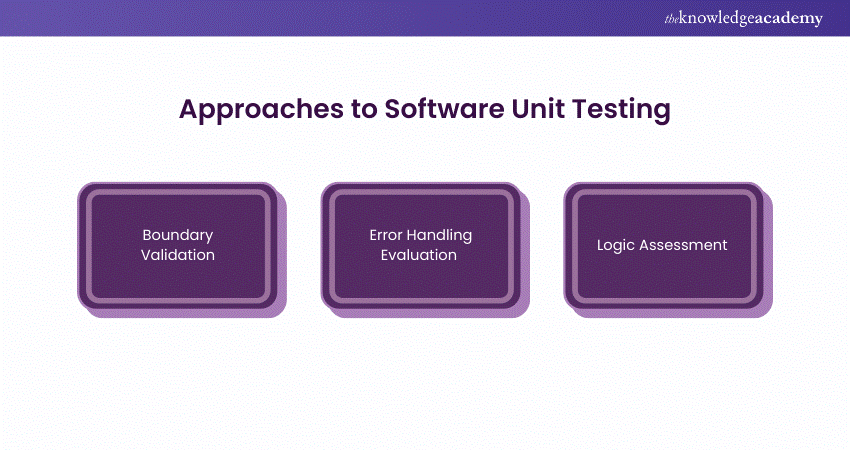
Boundary Validation
Boundary validation in Unit Testing focuses on examining how a unit behaves at the extremes of its input domain. This method tests the unit's behaviour when inputs are at their minimum, maximum, or precisely at boundary values. By rigorously checking these boundary conditions, developers can identify potential issues, such as off-by-one errors or unexpected behaviours that could emerge as inputs near these critical points.
Error Handling Evaluation
Error handling evaluation tests how a unit reacts to various error scenarios or exceptional circumstances. This testing ensures that the unit correctly identifies, reports, and handles errors or unexpected conditions robustly and reliably. By evaluating error-handling mechanisms, developers aim to confirm that the software manages failures gracefully and avoids unintended outcomes or crashes.
Logic Assessment
Logic assessment in Unit Tests is the procedure conducted to test and verify the correctness of decision-making and computational processes executed by the software. In particular, the method tests the internal logic of the code, including control flow (if-else, loops), algorithms, and business rules. Test cases should be created such that they keep in view the fact that they cover each logical path and branch of the application so that the software can run properly in every kind of situation.
Dive into the world of software testing and automation with Software Testing Automation Course.
How do Unit Tests work?
Unit Testing involves four main phases:
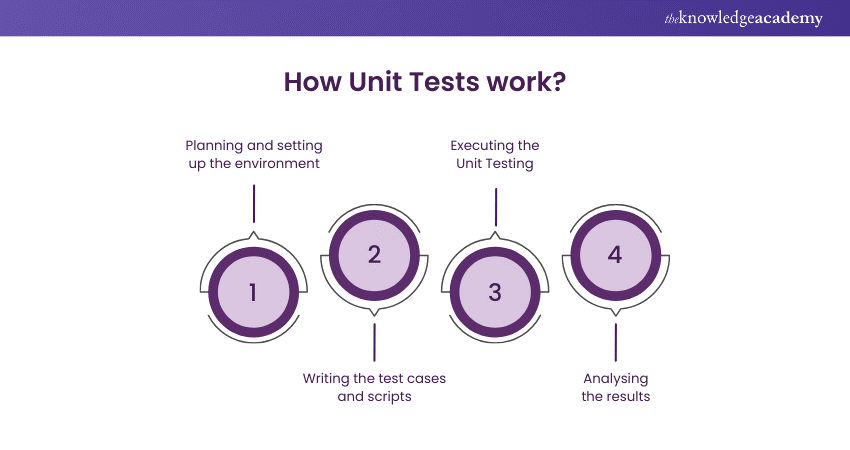
a) Planning and Setting up the Environment: During this phase, developers decide which units of the code need testing and how to effectively execute all relevant functionality for each unit. This setup is crucial for preparing the testing landscape.
b) Writing the Test Cases and Scripts: Here, developers write the actual Unit Test code and prepare scripts to execute the tests. This stage involves creating detailed tests that cover various scenarios the software might encounter.
c) Executing the Unit Testing: In this phase, the Unit Tests are run, and the behaviour of the code for each test case is observed. This step reveals whether the code performs as expected under different conditions.
d) Analysing the Results: After testing, developers analyse the results to identify any errors or issues in the code. Based on this analysis, necessary fixes are applied to improve the software’s stability and functionality.
Test-driven Development (TDD) is a common strategy employed in Unit Testing, where a test is written before the actual application code. Initially, this test will fail since the corresponding functionality doesn't exist yet. The developer then writes just the code required to make the test pass, promoting high-quality, consistent coding practices.
Effective Unit Testing Practices include the following:
a) Running each test case in isolation, using stubs or mocks to simulate external dependencies. This ensures that tests only focus on the unit under test.
b) Concentrating on critical features of the unit under test rather than testing every single line of code.
c) Using assertions in the code to verify each test case. These assertions help the testing framework to execute tests and report failures.
d) Performing tests frequently and early in the development cycle to catch issues as soon as possible.
e) After thorough Unit Testing, the next step typically involves integration testing, which evaluates how different components of the software interact with each other.
Elevate your Software Testing skills with our Introduction to Unit Testing Course - join us now!
Software Unit Testing Methodologies
Software Unit Testing methodologies are pivotal in ensuring code quality and reliability. Let’s dive into the techniques that equip developers to catch bugs early and build robust software:
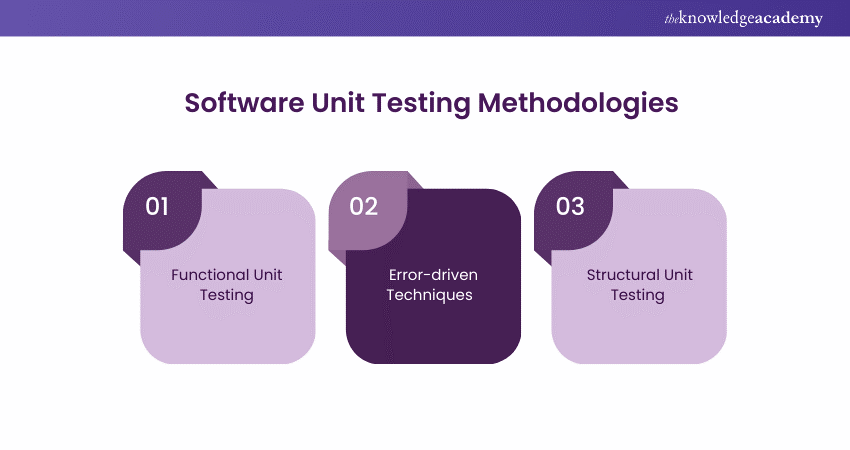
Functional Unit Testing
This type of testing evaluates individual units of code based on their functional requirements or specifications. Test cases are crafted to ensure that each unit performs its intended function correctly, adhering to the specified behaviour or business logic. Functional Unit Testing verifies that the units deliver the expected outputs for a given set of inputs, thus validating their functionality and compliance with requirements.
Error-driven Techniques
These techniques focus on creating test cases specifically designed to trigger and assess the error-handling capabilities within code units. The goal is to expose vulnerabilities or weaknesses in error detection, reporting, and recovery processes. By intentionally inducing errors or exceptional conditions, developers can evaluate the robustness and effectiveness of error handling mechanisms, ensuring that the software can handle failures gracefully and avoid undesirable outcomes.
Structural Unit Testing
Also known as white-box testing, this approach tests the internal structure and implementation details of code units. Test cases are designed based on the code structure, such as branches, loops, and paths, to achieve comprehensive code coverage. Structural Unit Testing aims to verify the correctness of the code's logic, identify any potential bugs or defects, and ensure that all execution paths are tested. This enhances the reliability and quality of the software.
Unlock the key to successful Software Testing careers with our ISTQB Software Testing Foundation Course - start your journey to professional certification today!
Exploring Unit Testing Best Practices
Here are some of the essential practices to Unit Testing:
Asserting Once
This best practice recommends limiting the number of assertions in each Unit Test to just one. By focusing on verifying a single logical behaviour or outcome, the tests become clearer, more maintainable, and easier to read. This approach helps ensure that each test case remains focused on a specific aspect of the unit's behaviour, simplifying the process of diagnosing and fixing any issues.
Implementing Unit Testing
Integrating Unit Testing at the start of the Software Development process is crucial. This involves writing unit-level tests alongside the implementation code to ensure they are comprehensive, relevant, and aligned with functional requirements. Early adoption of Unit Testing allows developers to identify and rectify defects sooner, ultimately enhancing code quality and reducing overall quality assurance costs.
Using a Unit Test Framework
Adopting a Unit Test framework provides a structured and standardised method for writing and executing tests. These frameworks typically offer features such as test runners, assertions, and setup/teardown mechanisms, which streamline the testing process and promote consistency across tests. By leveraging such frameworks, developers can facilitate easier and more productive test development, which enhances collaboration within development teams.
Automating Unit Testing
Automating Unit Testing involves using tools and scripts to run tests automatically without manual intervention. This increases the efficiency, repeatability, and reliability of the tests, enabling quicker feedback cycles and continuous integration. Automation helps developers quickly identify regressions, validate changes to the code, and maintain the integrity of the software, fostering a culture of quality and agility within the team.
Unit Testing Advantages
Here's a breakdown of the benefits of Unit Testing in Software Development:
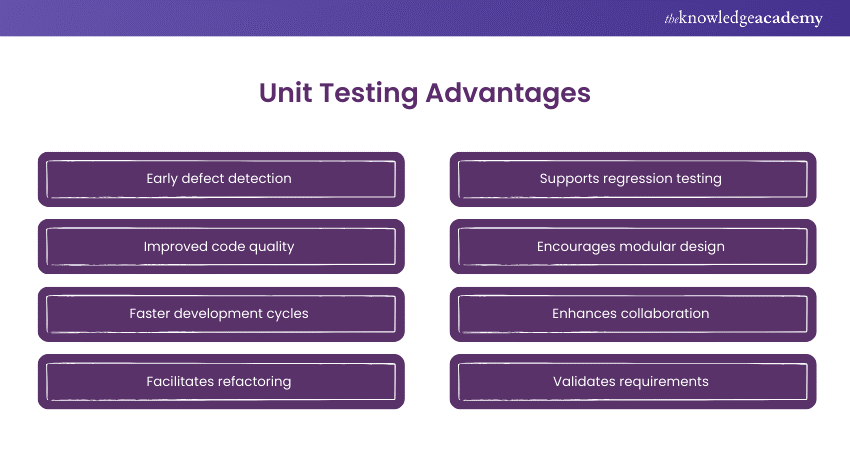
a) Early Defect Detection: Unit Testing allows developers to catch defects early in the development process while they are still localised, enabling them to address issues before they escalate into more significant problems.
b) Improved Code Quality: By testing individual units of code in isolation, Unit Testing helps enhance the overall quality of the code. This isolation reduces the likelihood of introducing bugs and errors into the software.
c) Faster Development Cycles: Unit Testing provides rapid feedback on code changes, which facilitates quicker iterations and refinements. This speed helps developers make multiple small improvements efficiently, shortening the overall development cycle.
d) Facilitates Refactoring: Unit Testing acts as a safety net that allows developers to refactor code confidently. It ensures that the system’s functionality remains intact even after changes are made.
e) Supports Regression Testing: Unit Tests form the basis for regression testing, ensuring that new code changes do not inadvertently disrupt existing functionality.
f) Encourages Modular Design: Unit Testing promotes the separation of concerns and modularisation of code, leading to more maintainable and extensible software. This approach supports building software that is easier to understand and update.
g) Enhances Collaboration: Unit Tests serve as executable documentation of code behaviour, facilitating collaboration among team members by promoting a shared understanding of the codebase.
h) Validates Requirements: Unit Testing ensures that each code unit operates according to the specified requirements and behaves as expected, thereby validating that the software functions correctly.
Gain an understanding of how to perform advance Performance Testing with JMeter Training Course and learn concepts of JMeter.
Unit Testing Disadvantages
Here are some challenges and limitations associated with Unit Testing:
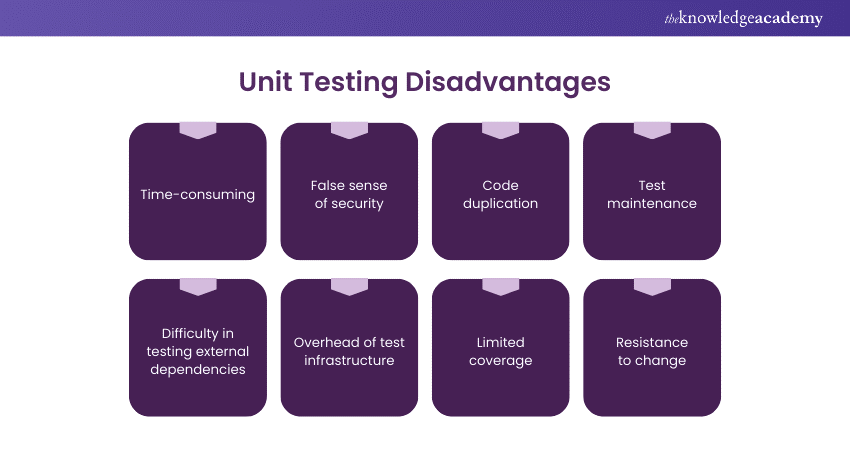
a) Time-consuming: Scripting and maintenance of Unit Tests can be particularly time-consuming for large and complex codebases, potentially slowing down the development process.
b) False Sense of Security: Unit Tests check the behaviour of individual units in isolation, which might not reveal integration issues or interactions between components, creating a false sense of security.
c) Code Duplication: Writing Unit Tests often involves duplicating logic from the implementation code, leading to redundancy and increased maintenance overhead.
d) Test Maintenance: As the codebase evolves, Unit Tests require frequent updates to stay relevant, adding to the maintenance burden.
e) Difficulty in Testing External Dependencies: Unit Tests can be challenging to write for code units that rely heavily on external dependencies like databases, network services, or third-party libraries.
f) Overhead of Test Infrastructure: Establishing and maintaining the infrastructure for testing, including test frameworks, mock objects, and test data, can be complex and resource intensive.
g) Limited Coverage: Unit Tests may only cover a limited portion of the codebase, potentially leaving significant gaps that could harbour undetected defects.
h) Resistance to Change: Developers might resist writing Unit Tests due to perceived time constraints or lack of expertise, which can result in poor test coverage and diminished testing effectiveness.
Advance your Automation Testing skills with JUnit 5 by registering in Automation Testing With JUnit 5 Course
Unit Testing Examples
Unit Testing is adopted across various frameworks and environments to ensure that individual components behave as expected. Here are some examples of how Unit Testing is applied in diverse programming contexts:
1) React Native Unit Testing: React Native is a popular framework for developing mobile applications that benefit significantly from Unit Testing. Tools such as Enzyme and Jest are commonly used for testing. Jest is a comprehensive testing framework that enables developers to write tests for React Native components, ensuring the user interface functions as expected.
Enzyme complements Jest by offering utilities for rendering and interacting with React components in tests. Together, they enable thorough testing of state changes, component logic, and event handling, helping to catch issues early in the development process.
2) Node.js Unit Testing: Unit Testing is essential in the Node.js environment for validating the functionality of JavaScript code, especially in backend applications. Mocha is a popular test framework that provides a simple interface for writing test cases, while Chai provides robust assertion libraries to validate code behaviour. These tools often test APIs, individual functions, and modules, ensuring the server-side logic is error-free.
3) Angular Unit Testing: Angular is a framework for building web applications that integrate Unit Testing as a core part of its development process. Jasmine is the default testing framework in this case, providing a syntax for writing easy-to-read and maintained test cases.
Karma, a test runner, executes these tests and ensures cross-browser compatibility. Angular's Unit Testing focuses on modules, components and services, allowing developers to test everything from business logic to user interface interactions.
4) Android Unit Testing: In Android development, Unit Testing validates the logic of Java-based components. JUnit is the standard framework for writing test cases for Android Applications, allowing developers to test individual methods, classes, and interactions within the app.
Espresso is commonly used for user interface testing to simulate user actions and validate UI behaviour. By combining JUnit for logic tests and Espresso for UI tests, developers can ensure that their Android apps are functional and user-friendly.
Learn to run efficient Automated Tests with our Software Testing Automation Course and gain insights about web and mobile testing
Conclusion
In Software Development, Understanding What is Unit Testing is the thread that weaves reliability into every feature. It’s the quiet assurance that your digital creations will stand the test of time . We hope this blog guides you towards crafting codes that are formidable and user-friendly.
Master Automation Testing using TestComplete! Enhance your skills, streamline your testing processes, and achieve efficiency. Join today!
Frequently Asked Questions

Unit Testing is primarily focused on functionality and preventing bugs, while QA testing involves different methods such as system testing, integration testing, and User Acceptance Testing (UAT).

Unit Testing involves testing individual components or units of code to ensure they work as expected. UI testing ensures that the graphical interface of an application behaves as expected.

The Knowledge Academy takes global learning to new heights, offering over 30,000 online courses across 490+ locations in 220 countries. This expansive reach ensures accessibility and convenience for learners worldwide.
Alongside our diverse Online Course Catalogue, encompassing 19 major categories, we go the extra mile by providing a plethora of free educational Online Resources like News updates, Blogs, videos, webinars, and interview questions. Tailoring learning experiences further, professionals can maximise value with customisable Course Bundles of TKA.

The Knowledge Academy’s Knowledge Pass, a prepaid voucher, adds another layer of flexibility, allowing course bookings over a 12-month period. Join us on a journey where education knows no bounds.

The Knowledge Academy offers various Software Testing Courses, including the ISTQB Software Testing Foundation Course and the ISTQB Advanced Test Automation Engineer Course. These courses cater to different skill levels, providing comprehensive insights into Software Testing Job Roles.
Our Business Analysis Blogs cover a range of topics related to Software Testing, offering valuable resources, best practices, and industry insights. Whether you are a beginner or looking to advance your Software Testing skills, The Knowledge Academy's diverse courses and informative blogs have got you covered.
Upcoming Business Analysis Resources Batches & Dates
Date
 Unit Testing Course
Unit Testing Course
Fri 24th Jan 2025
Fri 21st Mar 2025
Fri 2nd May 2025
Fri 27th Jun 2025
Fri 29th Aug 2025
Fri 3rd Oct 2025
Fri 5th Dec 2025







 Top Rated Course
Top Rated Course



 If you wish to make any changes to your course, please
If you wish to make any changes to your course, please


